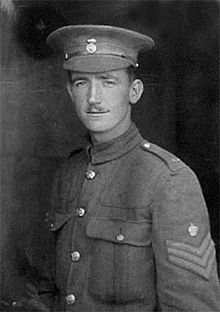Captain Frederick Barter VC MC (17 January 1891 – 15 May 1953) was a British Army officer and a Welsh recipient of the Victoria Cross (VC), the highest and most prestigious award for gallantry in the face of the enemy that can be awarded to British and Commonwealth forces.
Frederick Barter | |
|---|---|
 | |
| Nickname(s) | Fred |
| Born | 17 January 1891 Cardiff, Glamorganshire, Wales |
| Died | 15 May 1953 (aged 62) Poole, Dorset, England |
| Allegiance | |
| Service | |
| Years of service | 1908-1922 |
| Rank | Captain |
| Unit | Royal Welch Fusiliers |
| Battles / wars | |
| Awards | Military Cross Cross of St. George (Russia) |
He was "born at 60 Daniel Street, Cathays, Cardiff, one of three children born to Mr and Mrs Samuel Barter". His initial education was at Crwys Road Board School in Cardiff and, "after working as a collier and later as a porter on the Great Western Railway", Barter joined the British Army as a private in the Royal Welsh Fusiliers (later the Royal Welch Fusiliers) in December 1908.[1] After completing his terms of service he transferred to the army's Special Reserve before "working as a stove repairer for the Cardiff Gas Light & Coke Company" when the First World War broke out in the summer of 1914.[1]
On 5 August, the day after the British declaration of war on Germany, Barter was mobilised for service with the 1st Battalion of the RWF. The battalion "landed at Zeebrugge on 7 October" and, "by the 30th of the month", had been "reduced to 86 men and one officer after heavy fighting at Zonnebeke and Zandvoorde".[1]
He was 24 years old, and a company sergeant major in the Special Reserve, The Royal Welch Fusiliers, British Army, attached to the 1st Battalion, The Royal Welch Fusiliers during the First World War when the following deed took place for which he was awarded the VC.
On 16 May 1915 at Festubert, France, Company Sergeant-Major Barter, when in the first line of German trenches, called for volunteers to enable him to extend our line, and with the eight men who responded, he attacked the German position with bombs, capturing three German officers, 102 men and 500 yards of their trenches. He subsequently found and cut 11 of the enemy's mine leads situated about 20 yards apart.[2]
He was commissioned a Second Lieutenant in the Special Reserve, The Royal Welch Fusiliers, 26 August 1915.[3][4]
On 16 March 1917 he was seconded on probation with the Indian Army and was attached to the 4th battalion 3rd Queen Alexandra's Own Gurkha Rifles, with seniority as a Second Lieutenant of 26 May 1916.[5] He was promoted Lieutenant 26 May 1917.[4] He was awarded the Military Cross in the London Gazette 26 July 1918. The MC's citation reads as follows:
For conspicuous gallantry and devotion to duty when ordered to make a flank attack.
He led his two platoons up a precipitous hill and turned the enemy's flank. Then, placing one platoon with two Lewis guns to command the enemy's line of retreat, he gallantly led an attack with the other platoon from the rear and flank, killing or
capturing practically the whole garrison.[4]
He was admitted to the Indian Army on 6 May 1918, promoted captain on 26 May 1920 and retired from the Indian Army on 5 November 1922.[4]
His VC is displayed at the Royal Welch Fusiliers Museum at Caernarfon Castle.[6]
References
edit- ^ a b c Batchelor & Matson 2011, p. 149.
- ^ "No. 29210". The London Gazette. 29 June 1915. p. 6269.
- ^ London Gazette 25 August 1915
- ^ a b c d Batchelor & Matson 2011, p. 150.
- ^ January 1919 Indian Army List
- ^ Batchelor & Matson 2011, p. 151.
Bibliography
edit- Batchelor, Peter; Matson, Christopher (2011). The Western Front 1915. VCs of the First World War. Stroud, Gloucestershire: The History Press. ISBN 978-0-7524-6057-4.
- Buzzell, Nora, ed. (1997). The Register of the Victoria Cross. Cheltenham, Gloucestershire: This England Alma House. ISBN 0-906324-27-0.
- Harvey, David (2000). Monuments to Courage. Naval & Military Press Ltd. ISBN 1-84342-356-1.
- Oldfield, Paul (2014). Victoria Crosses on the Western Front August 1914–April 1915: Mons to Hill 60. Pen and Sword Books. ISBN 978-1783030439.
External links
edit- Burial location of Frederick Barter "Dorset"
- Location of Frederick Barter's Victoria Cross "Royal Welch Fusiliers Museum"